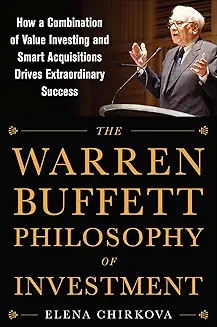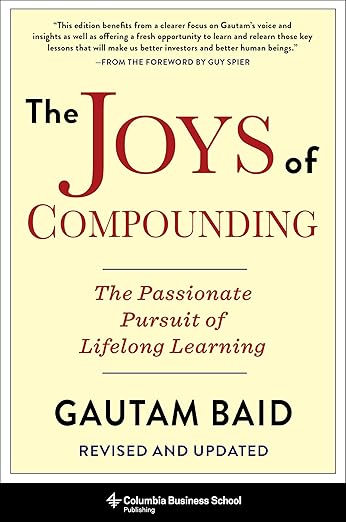Your cart is currently empty!
Category: Uncategorized
-
02.0016 The Warren Buffett Philosophy of Investment

02.0016 The Warren Buffett Philosophy of Investment
2015 Elena Chirkova
McGraw-Hill Education
Chapter Notes Introduction 1. Fore Father 2. What Kind of Business Does Warren Buffett Like? 3. Warren Buffett’s Investment Principles 4. Comparing Buffett with Other Investors 5. An Excursion Through Financial Theory and Corporate Finance with Warren Buffett 6. The Use of Debt by Berkshire Hathaway 7. Early Acquisitions: the Strategy Has Crystallized 8. “Who Is the Fairest of Them All”: the Role of Image in Buffett’s Investment Strategy 9. Buffett as a Strategic and Portfolio Investor 10. Reputation at Work 11. Beyond the Frontiers of Investment Theory Conclusion -
02.0015 The Joys of Compounding

The Joys of Compounding – The Passionate Pursuit of Lifelong Learning
2020 Gautam Baid
Columbia Business School
Chapter Notes 1. Introduction: The Best Investment You Can Make Is an Investment in Yourself SECTION I – ACHIEVING WORLDLY WISDOM 2. Becoming a Learning Machine 3. Obtaining Worldly Wisdom Through a Latticework of Mental Models 4. Harnessing the Power of Passion and Focus Through Deliberate Practice SECTION II – BUILDING STRONG CHARACTER 5. The Importance of Choosing the Right Role Models, Teachers, and Associates in Life 6. Humility Is the Gateway to Attaining Wisdom 7. The Virtue of Philanthropy and Good Karma 8. Simplicity Is the Ultimate Sophistication 9. Achieving Financing Independence 10. Living Life According to the Inner Scorecard 11. The Key to Success in Life Is Delayed Gratification SECTION III – COMMON STOCK INVESTING 12. Building Earning Power Through a Business Ownership Mind-Set 13. Investing Between the Lines 14. The Significant Role of Checklists in Decision-Making 15. Journaling Is a Powerful Tool for Self-Reflection 16. Never Underestimate the Power of Incentives 17. Always Think About the Math, but Avoid Physics Envy 18. Intelligent Investing Is All About Understanding Intrinsic Value 19. The Three Most Important Words in Investing 20. Investing in Commodity and Cyclical Stocks Is All About the Capital Circle 21. Within Special Situations, Carefully Study Spinoffs SECTION IV – PORTFOLIO MANAGEMENT 22. The Holy Grail of Long-Term Value Investing 23. The Market Is Efficient Most, but Not All, of the Time 24. The Dynamic Art of Portfolio Management and Individual Position Sizing 25. To Finish First, You Must First Finish SECTION V – DECISION MAKING 26. Read More History and Fewer Forecasts 27. Updating Our Beliefs in Light of New Evidence 28. Life Is a Series of Opportunity Costs 29. Pattern Recognition 30. Acknowledging the Role of Luck, Chance, Serendipity, and Randomness 31. The Education of a Value Investor -
Business-Driven Investing
Building Earning Power Through a Business Ownership Mind-Set
Benjamin Graham
Investing is most intelligent when it is most businesslike.
Warren Buffett 1977 Letter to shareholders:
Our experience has been that pro-rata portions of truly outstanding business sometimes sell in the securities at a very large discount from the prices they would command in negotiated transactions involving entire companies. Consequently, bargains in business ownership, which simply are not available directly through corporate acquisition, can be obtained indirectly through stock ownership. When prices are appropriate, we are willing to take very large positions in selected companies, not with any intention of taking control and not foreseeing sell-out or merger, but with the expectation that excellent business results by corporations will translate over the long term into correspondingly excellent market value and dividend results for owners, minority as well all majority…
We invested $10.9million in Capital Cities Communications during 1977… Capital Cities possess both extraordinary properties and extraordinary management. And these management skills extend equally to operations and employment of corporate capital. To purchase, directly, properties such as Capital Cities owns would cost in the area of twice our cost of purchase via the stock market, and direct ownership would offer no important advantages to us. While control would give us the opportunity-and the responsibility-to manage operations and corporate resources, we would not be able to provide management in either of those respect equal to that now in place. In effect, we can obtain a better management result through non-control than control.
This is an unorthodox view, but one we believe to be sound!
✅ 1. The possibility of partly owning a business with a small investment corpus.
✅ 2. minimizing r4isk through diversification.
✅ 3. Access to top-notch managers to run the business.
✅ 4. Buying business ownership on your own terms.
✅ 5. Opportunity to shoot rare, fast-moving elephants.
✅ 6. The invaluable flexibility of a quick and smooth exit.
The Significant Role of Checklists in Decision-Making
Charlie Munger
Checklist routines avoid a lot of errors. You should have all this elementary [worldly] wisdom and then you should go through a mental checklist in order to use it. There is no other procedure in the world that will work as well.
✅ 1. Income Statement (Profit and Loss Account) Analysis
Sales growth
Gross profit margin
Interest income (usually shown as “other income”)
Interest expense
Employee cost
Other expenses
Taxes
Net profit margin
✅ 2. Cash Flow Analysis
Cash flow from operating activity (CFO)
Capital expenditure (capex)
Total debt
Cash balance
Free cash flow (FCF)
✅ 3. Return Ratios Analysis
Self-sustainable growth rate (SSGR)
Profit before tax / average net fixed asset
Pretax return on tangible equity
Return on capital employed
✅ 4. Operating Efficiency Analysis
Net fixed assets
Capital work in progress
Share capital
Debt-to-equity ratio
✅ 5. Balance Sheet Analysis
Net fixed Assets
Capital work in progress
Share capital
Debt-to-equity ratio
✅ 6. Management Analysis
Study the background and credentials of promoters and search the Internet (ChatGPT) for any corporate governance issues. Use keywords like “fraud”, “scam”, “litigation”, “investigation”.
全面搜查在前10年内对年报有没有不操守行为、违反证券交易所条例、财务困境通知等等:给评语、评分及评级:
Management red flags include exorbitant salaries, perks, and commissions (most worrisome if paid during a period of losses); a high percentage of insider holdings being pledged; promoters merging their weaker privately owned companies into their publicly listed company; engaging in significant related party transactions; appointing relatives who lack adequate qualifications; using aggressive accounting practices; frequently changing auditors; changing the company name to include buzzwords from the hot sectors currently in high demand; and engaging in overly promotional activities; such as quoting broker reports for its revenue or profit guidance and issuing frequent but meaningless press releases and announcements. A hard sell usually indicates that some form of financing is impending. Always read the “Liquidity and Capital Resources” section in annual and quarterly Securities and Exchange Commission filings to assess the capital-raising needs of the business you are researching.
✅ 7. Munger’s Psychological Checklist of the Standard Causes of Human Misjudgment
Bias from mere association.
Underestimating the power of rewards and punishment.
Underestimating bias from one’s own self-interest and incentives.
Self-serving bias.
Self-deception and denial.
Bias from consistency and commitment tendency.
Bias from deprival syndrom.
Status quo bias and do-nothing syndrome.
Impatience.
Bias from envy and jealousy.
Distortion by contract comparison.
Bias from anchoring.
Overinfluence from vivid or recent events.
Bias from reciprocation tendency.
Bias from overinfluence by liking tendency.
Bias from overinfluence by social proof.
Bias from overinfluence by authority.
Sense making.
Reason respecting.
Believing first and doubting later.
Memory limitations.
Do-something syndrome.
Mental confusion from say-something syndrome.
Emotional arousal.
Mental confusion from stress, physical or psychological pain, or the influence of chemicals or diseases.
Intelligent Investing is All About Understanding Intrinsic Value
Benjamin Graham, Security Analysis
A general definition of intrinsic value would be that value which is justified by the facts-eg,. assets, earnings, dividends, definite prospects. In the usual case, the most important single factor determining value is now held to be the indicated average future earning power [emphasis added]. Intrinsic value would then be found by first estimating this earning power, and then multiplying that estimate by an appropriate “capitalizational factor’.
Its Owner Earnings That Counts
For value investors, the earnings used for valuation purposes are the owner earnings. Net income and EPS are reported figures under accounting principles, but the actual cash that business owner is able to finally take out is quite different. Owner earnings tell us how much cash come into the business owner’s pockets, which is meant to be actual, spendable cash, not inventory and receivables. This is why Buffet calls it owner earnings. Remember, buying a stock is buying a part ownership in a business.
Gautam Baid: Some Thoughts on Value Traps
Most of the time, switching from a high P/E stock to one with a low P/E proves to be a mistake. Value traps are abundant and all-pervasive. I have learned to respect the market’s wisdom. Everything trades at the level it does for a reason. High quality tends to trade at expensive valuation and junk or poor quality is frequently available at cheap (or the harmful “optically cheaper on a relative basis”) valuation. It took me many years to learn this big market lesson: expensive is expensive for a reason and cheap is cheap for a reason.
In stock market, price usually move first, and the reported fundamentals follow.
Value trap are businesses that look cheap but actually are expensive. This could happen for a variety of reasons:
✅Cyclicality of earnings.
✅App risk.
✅Bad capital allocation by the mangement
✅Governance issues
The Three Most Important Words In Investing
A Margin of Safety
Buffett’s adaption of margin of safety:
Rule No.1: Never lose money
Rule No.2: Never forget Rule No.1
It takes a fairly short time to learn how to make money, but it takes a life-time to learn how no not lose it. A margin of safety in investing is necessary to avoid “compounding in reverse”.
One single year of big loss can undo all the hard work and sacrifices of the past.
Example 1: +15% per year for 6 years, CAGR = 19.11%.
Example 2: +30% per year for 5 years, -30% on 6th year, CAGR = 12.23%.
